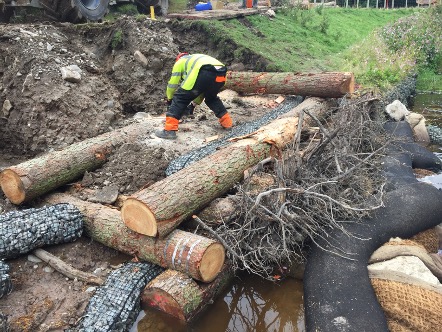A live crib wall of willow were used to protect a high pressure gas pipe that had become exposed due to significant river bed scour and bank erosion on a section of the Afon Elwy near St Asaph.
A high pressure gas pipe had become exposed due to significant river bed scour and bank erosion on a section of the Afon Elwy near St Asaph.
Attempts had been made previously to protect the pipeline with a large gabion structure, but this had actually accelerated the erosion problems directly over the pipe.
Salix were asked by the client to investigate and come up with a design that would prevent the pipeline from further damage and stabilise the river bed and banks longer term.
Cbec eco-engineering undertook a fluvial audit, topographical survey and hydraulic modelling to review the existing geomorphological processes and hydraulic conditions and to assess what interventions could be made.


Existing conditions modelling showed that a large gabion structure upstream of the pipe enforce the flow to make a sudden step to the left, and the shoulder of boulders (which the end gabions sit on) and the end gabions themselves act as a restriction to flow.
The last few gabions have an area of scour in behind them.
Existing conditions modelling showed two mechanisms for erosion on the right bank: at all flows there is an area of recirculation with appreciable reverse velocities on the right bank downstream of the gabions; at high flows there is a fast moving downstream jet of flow from over the top of the gabions and in behind them into an obvious area of erosion.
The gabions jut out into the flow and enforce a left turn, and as the gabions end, the flow separates with a shear layer, expands considerably, and causes the recirculation. The proposed design was to remove the gabion structure and re-grade the right bank.



As the flow in the design area is complex, being composed of a sudden flow direction change and expansion, design conditions modelling was necessary to provide a measure of the success of the design and to guide further design iteration.
The model also demonstrated that the gabion structure was splitting flood flows and creating secondary flow cells. The combination of secondary flows and the deflection of flow of the gabion has led to the bank erosion and bed scour to a depth of over 3m, exposing the pipe.
The large bed scour feature was now self sustaining. A second design iteration model was run to explore the impact of removing the gabions structure and partially filling in the bed scour pool.
Works were undertaken to remove the large 4m high gabion structure. Stone from the gabions was used to partially fill in the large scour pool that had exposed the gas pipe.
Removing this structure gave the channel more room and dissipated shear stress over the pipe. Works were undertaken using Salix’s Menzi Muck spider excavator due to the limited access and steep banks .



Directly over the pipe the area of eroded bank was build back up using an innovative large wood and live crib wall design.
This would ensure that the most robust bioengineering technique would provide structural integrity over the pipeline but also slow the flow and allow native bankside habitat to develop.
Construction of the live crib wall with large rootwards. The tree roots slow the flow locally in flood events and provide shade and shelter for aquatic life




